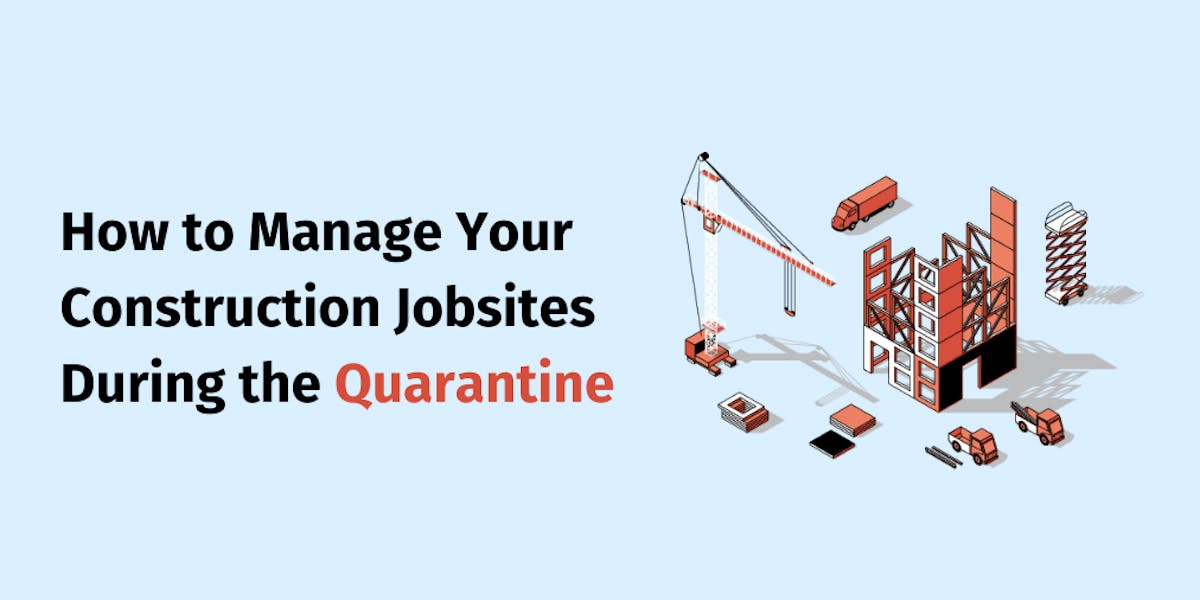Managing a construction site during normal circumstances isn’t always easy. But now that the coronavirus is impacting the construction industry and most US states are under quarantine, managing a jobsite is more complicated than ever.
Now, to successfully run a construction project, you have to increase site safety—while working with skeleton crews and limited supplies. And though that’s a daunting task, it’s not an impossible one.
Here are five best practices to help keep your workers safe and your projects moving forward during quarantine:
1. Form a Dedicated COVID Communications Team
Communication is always crucial to jobsite safety. But it’s more important now than ever. Because if you don’t keep your crews abreast of the new safety regulations, they can’t work responsibly during the COVID-19 crisis. And if they don’t work responsibly, they are at a greater risk of getting sick on the job—which could mean a site shut down for you and even worse for them.
So, if you haven’t already, you should follow suit with construction companies across America and establish a COVID-19 communications team.
These teams meet daily (virtually or by phone) to keep up-to-date on the latest COVID challenges affecting the construction industry. They’re responsible for communicating and implementing new safety protocols, offering support to employees and sharing updates and information with workers and stakeholders across projects.
Here are a few functions that a dedicated COVID communications team should perform:
- COVID response teams should work as liaisons to keep communication lines open and honest between employees, subs, stakeholders, and owners.
- They should provide resources to help workers cope with the stresses of working during the health crisis.
- They should create written guidelines specific to COVID-19 protocols and make sure these are communicated to all staff and crew members.
- They should use mobile or online apps and/or your company’s intranet to help reinforce safety guidelines and proper working procedures, as well as provide ways for employees to safely report any violations they see.
2. Oversee Projects Remotely
Thanks to distancing guidelines, in-person meetings are out. Project meetings should take place via video chat or over the phone whenever possible. And project management should be conducted remotely.
Luckily for owners, project managers, and COVID communications teams, there are plenty of technologies available to help manage teams and projects from a distance. Here are a few solutions to consider:
- For virtual meetings and video conferencing: GoToMeeting, Zoom and Cisco Webex
- For file sharing: Google G Suite, Dropbox, and OneDrive
- For project tracking and reporting: Changepoint, Trello, and Wrike
- For scheduling and payroll: ClockShark, FreshBooks and Findmyshift
Save Time and Money with ClockShark
3. Stagger Crew Movements to Achieve Safe Physical Distancing
Social distancing guidelines require that six feet be maintained between workers. And the CDC recommends no group meetings of over 10 people.
So, how can you still get site work done?
You can start by staggering the movements of everyone who needs to come on and off your sites.
Here are a few things you can stagger to limit the number of people on-site at one time:
- Stagger trades instead of stacking them.
- Stagger start and end times.
- Stagger breaks.
- Stagger lunches.
- Stagger delivery times.
Along with staggering crew movements, you’ll also need to think about how to control movements in high-risk areas like hallways, elevators, and hoists.
4. Track and monitor your workforce
One of the most important ways to keep your jobsites safe is to monitor the health of your workforce. To do this, screening protocols should be implemented to test that all employees are healthy when they arrive on-site.
Have your supervisors take these steps before they allow employees’ to begin work:
- Maintain a daily attendance log.
- Check employees’ temperatures, and do not allow anyone with a temperature of 100.4 °F or higher to work. Give them instructions to seek medical advice and not to come back to work until they are fever-free, without medication, for at least 24 hours.
- Ask employees if they (or anyone in their home) have been exposed to someone with a confirmed case of COVID-19. If the answer is yes, send them home.
- Ask employees if they have had symptoms related to COVID-19, such as fever, cough or shortness of breath, within the past 48 hours. If yes, send them home.
And since the latency period of COVID-19 is around 14 days, it’s also important to track where your employees have worked and when. Because if one of your employees tests positive for COVID-19, you’ll need to provide this information to public health authorities and let them know which other employees are most likely to have been exposed.
5. Implement Recommended On-Site Safety Measures
COVID-19 safety guidelines for construction sites vary slightly by city and state. But most have these regulations in common:
- Assign COVID-19 supervisors at each jobsite to ensure the site and its workers stay in compliance with new safety regulations.
- Conduct health screenings as employees arrive on site (see above).
- Place markers at 6 feet intervals to ensure proper distancing wherever possible.
- Place wash stations or hand sanitizer in multiple locations throughout your sites. And be sure that these supplies are well maintained.
- Post signs in highly visible areas that explain these hygienic best practices:
- Keep hands away from the face
- Wash hands often with soap and water for at least 20 seconds or uses hand sanitizer with at least 60% alcohol
- Do not congregate in lunch or break areas
- Cover coughs and sneezes with elbow
- Refrain from shaking hands, giving high-fives, etc.
- Wear PPE
- Discourage workers from sharing phones, desks, and offices.
- Discourage workers from sharing tools and equipment. But if sharing is necessary, make sure tools are sanitized before and after each use.
- Clean and disinfect frequently touched surfaces like workstations, keyboards, telephones, handrails, control buttons, and doorknobs
- Increase sanitation of public and/or portable bathrooms
- Avoid cleaning with pressurized water or air that could create bioaerosols.
Working during a worldwide health crisis is uncharted territory, but following these suggestions can help keep your business, your teams and your projects safe. For more information to help you during this time, visit ClockShark’s COVID-19 resource page.









